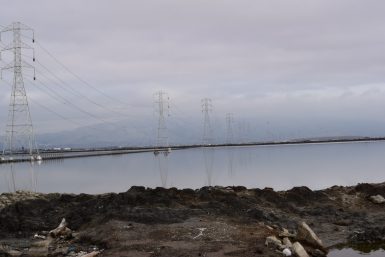 Pacific Gas and Electric (PG&E) recently completed the Newark – Ravenswood project, a seven-mile stretch on the southern section of the San Francisco Bay using the first novel full tension splice system in over 30 years.
Pacific Gas and Electric (PG&E) recently completed the Newark – Ravenswood project, a seven-mile stretch on the southern section of the San Francisco Bay using the first novel full tension splice system in over 30 years.
This new system uses 360° Swage technology as a means of pressing the splice onto the conductor, establishing electrical continuity and mechanical holding strength of the transmission line conductors and was awarded to Wilson Utility Construction Company and DMC Power, the manufacturer of Full Tension Swage connectors.
 Selecting the System
Selecting the System
Until now, the splice systems that were installed by PG&E over the last century had changed very little. Though each component in a transmission project must pass industry standards, those individual components still vary in tolerance due to complications with both the manufacturing and installation processes. PG&E became well aware of this issue in the early 90’s when they were experiencing higher than normal splice failures annually.
 The ANSI C119.4 accelerated aging test is designed to subject stress into the cable/splice system to predict life expectancy. Consistently meeting test requirements by controlling tolerances ensures better performance of all installed splices. PG&E became a driving force in urging ANSI to establish the higher stress level protocol - class “AA” - which was included in the current revision of 2011. While this higher standard was a major benchmark in improving the quality of transmission and distribution systems, as of today, there are no requirements to publish the number of samples that fall short of the pass/fail criterion due to uncontrollable stack up tolerances and inconsistencies in manufacturing and installation practices.
The ANSI C119.4 accelerated aging test is designed to subject stress into the cable/splice system to predict life expectancy. Consistently meeting test requirements by controlling tolerances ensures better performance of all installed splices. PG&E became a driving force in urging ANSI to establish the higher stress level protocol - class “AA” - which was included in the current revision of 2011. While this higher standard was a major benchmark in improving the quality of transmission and distribution systems, as of today, there are no requirements to publish the number of samples that fall short of the pass/fail criterion due to uncontrollable stack up tolerances and inconsistencies in manufacturing and installation practices.
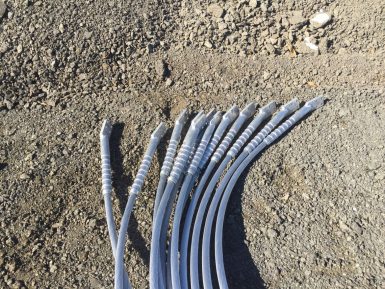 Legacy connector systems, such as the 3000 series aluminum alloy used for ACSR, or more recently, the ACSS 1100 alloy series, were manufactured from tube produced through an extrusion process. This extrusion process allowed for maximum tolerance control of a 2” diameter tube of ± .030 on Outer Diameter and ± .015 on the Inner Diameter, per ANSI H35.2.
Legacy connector systems, such as the 3000 series aluminum alloy used for ACSR, or more recently, the ACSS 1100 alloy series, were manufactured from tube produced through an extrusion process. This extrusion process allowed for maximum tolerance control of a 2” diameter tube of ± .030 on Outer Diameter and ± .015 on the Inner Diameter, per ANSI H35.2.
For the Ravenswood-Newark project, PG&E chose the DMC Power Swage system based on its aim-small, miss-small design concept when it comes to tolerance variability. DMC Power Swage connectors are manufactured from higher conductivity alloy using a gun drilling process that ensures smaller manufacturing variables (±.003) which contributes to our connector’s consistently passing ANSI class “AA” requirements. This reduces the accumulating tolerance variables that lead to lower compression ratios. Additionally, machining barrel Inner Diameters allow for a surface finish conducive to creating more contact spots with the ideal peak & valley profile. This coupled with flex-die technology, yielding twice the compression of hex and “U” die systems, assures repeatable and reproducible connections with the Swaged connection.
The goal for PG&E was to select a system that not only consistently met standards like ANSI, but also was built in a way to prevent installation issues. As PG&E’s Transmission Line Support Manager Chuck Stinnett, puts it “Installer dependency issues are what gets you, tighter controls on the manufacturing side help cover variables that happen in the field”. PG&E believes installation issues occur when they are considered in design i.e. inspection hole to insure the cable is inserted properly and go/no-go gauges to check proper compression you get with the Swage system.
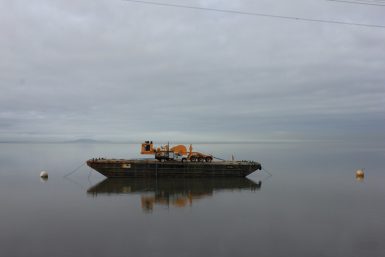 Ravenswood-Newark Installation
Ravenswood-Newark Installation
 As part of PG&E’s reliability development, the Ravenswood-Newark project contended with public roadways, railroad lines and the Dumbarton Bridge, found on Highway 84, and terminated in a dead end structure found within the San Francisco Bay. This line ran through the Don Edwards Wildlife Refuge, one of the most sensitive environmental area in Northern California and part of the largest wetland restoration project on the West Coast.
As part of PG&E’s reliability development, the Ravenswood-Newark project contended with public roadways, railroad lines and the Dumbarton Bridge, found on Highway 84, and terminated in a dead end structure found within the San Francisco Bay. This line ran through the Don Edwards Wildlife Refuge, one of the most sensitive environmental area in Northern California and part of the largest wetland restoration project on the West Coast.
Balancing the special environmental needs of the wetlands while building the 230kV line posed significant challenges: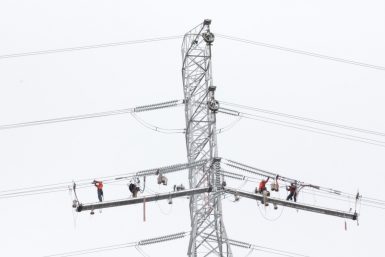
- The site only allowed for one dryland wire pulling location at the 2 mile point
- Installation required a barge anchored in the bay to pull the wire for one single 5 mile pull at the last dead end structure
- In addition to challenges pulling the wires due to the proximity to the San Francisco bay and the Cargill Salt ponds, the majority of the work was only accessible by helicopter.
- The project’s timeline was constrained considerably by line clearances, environmental regulations, applicable governing agency requirements and Cargill Property rules, who had deeded much of the wetlands to the state of California and the Federal Government.
- Due to current and future capacity needs, "High Temperature" 954 ACSS Cardinal conductor was chosen for the reconductoring projects
Construction began in May 2015 with guard structure netting installations and Tubular Steel Pole erection and the first 230kV clearance started on September 1, 2015.
Due to the length of the second 5.5-mile segment there was a need to install mid span sleeves at three separate locations as well as dead-end fittings on tension towers. With the work completed the line was re-energized on December 23, 2015.
Prior to installation Wilson Construction was asked to document the time allocated to replace temporary socks and swivels used to join conductor reels during the pulling operation with permanent Swage type splices. After completion, Chris Hughes, Wire Superintendent for Wilson Construction, determined that DMC Power:
- Swage fittings were approximately 25% more efficient than traditional compression fittings
- Tooling was lighter and easier to transport via the helicopters and out of lattice towers
- Swaged fittings reduced the project’s man-hours by approximately 900 hours and equated to a cost savings of approximately $100,000 dollars
 Splice Failure not unique to PG&E
Splice Failure not unique to PG&E
Having major splice failures with equipment that passed industry standards but operating within its normal design parameters is not unique to PG&E.
The Federal Energy Regulatory Commission (FERC), which approved the North American Electric Reliability Corporation’s (NERC) Reliability Standard (FAC-008-3), requires all Transmission Owners to determine normal and emergency facility ratings with respect to the most limiting component of the applicable equipment.
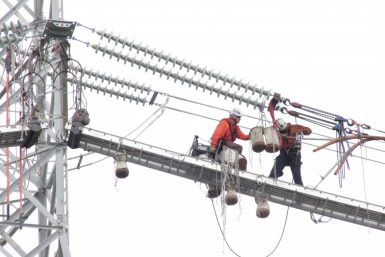 Currently very few Transmission Owners, if any, are establishing methodologies for Full Tension splices as the limiting component. In fact, spli ces are conspicuously absent in the standard's verbiage: "The scope of equipment addressed shall include, but not be limited to, transmission conductors, transformers, relay protective devices, terminal equipment, and series and shunt compensation."
Currently very few Transmission Owners, if any, are establishing methodologies for Full Tension splices as the limiting component. In fact, spli ces are conspicuously absent in the standard's verbiage: "The scope of equipment addressed shall include, but not be limited to, transmission conductors, transformers, relay protective devices, terminal equipment, and series and shunt compensation."
This sets up an interesting tension between the FERC and the Department of Energy. In a 2015 report on transmission and distribution components the Department of Energy called compression connectors for overhead lines the “weak links in the electricity delivery network, where power transmission can be limited by the connector resistance and disruptions can occur owing to mechanical failures.”
Although the facilities rating standard (FAC 008-3) does not come up for review until 2018, “Equipment Degradation” will be of particular concern as it relates to normal and emergency temperature operation of existing transmission lines. Given the number a recent NERC alerts related to failed splices, a discussion of splices being the limiting component would be practical.
